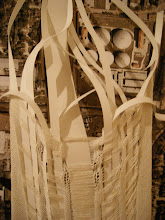
According to Koolhaas, 'old' architectural principles (composition, scale, proportion, detail) no longer apply when a building acquires Bigness. This was demonstrated in OMA's scheme for the development of "Euralille" (1990-94), a new centre for the city of Lille in France, a city returned to prominence by its position on the new rail route from Paris to London via the channel tunnel. OMA sited a train station, two centres for commerce and trade, an urban park, and 'Congrexpo' (a channel tunnel contemporary Grand Palais with a large concert hall, three auditoriums and an exhibition space).
Congrexpo, is the centerpiece for the plan. One large exterior wall is built of thin corrugated plastic flecked with tiny pieces of aluminum. This surface creates a hard, reflective shell on the outside, but from the interior the wall is translucent.
The building flows with the subtle curves which are a Koolhaas hallmark. The main entry hall has a sharply sloped concrete ceiling. On the exhibition hall ceiling, slim wood slats bows at the center. A staircase to the second floor zigzags upward, while the polished steel side wall slopes inwards, creating a wobbly mirror image of the stairs.
From Rem Koolhaas: "Lille has been shot to ribbons by the French intellectuals. The entire city mafia, I'd say, who call the tune in Paris, have renounced it a hundred per cent. I think that was partly because it has had no intellectual defence." (The Critical Landscape, by Arie Graafland and Jasper de Haan, 1997)
The most provocative space is created by simply subtracting the separations among the several infrastructure networks at their crossing--functions as a passenger exchange.





No comments:
Post a Comment